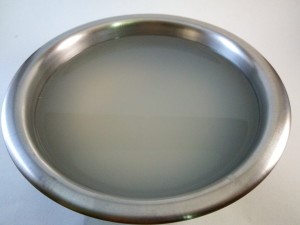8 Benefits of Arrowroot
Share
What is Arrowroot?
Arrowroot is a food starch that has been cultivated for thousands of years. The Arawak who were native to the Caribbean originally named it aru-aru meaning the ‘meal of meals’. These native Caribbean islanders put the plant to great use in cooking and various other applications. The common name ‘Arrowroot’ is derived from its use in healing wounds caused by poisonous arrows in the Central American region.
Arrowroot is actually the term used for the starch derived from the Maranta arundinacea plant. The starch is usually derived from the rhizomes of this perennial tropical herb but may also come from the entire plant. Another variety of arrowroot is derived from a plant called Zamia integrifolia or Florida arrowroot.
These days, arrowroot is mostly used as a thickening agent in food as a healthier, gluten-free alternative to common cornstarch. Cornstarch is often genetically modified, and even organic products are regularly GMO contaminated.
The plant itself is more than simply a thickening agent. The history of this plant goes back a very long way. Archaeologists have uncovered evidence of its cultivation going back 7000 years. It is believed to aid digestion, help treat urinary tract infections, and reduce inflammation and may even give the immune system a boost.
These days, most of the arrowroot grown for commercial purposes is cultivated in Central America, with the island of St. Vincent being the biggest producer.
Nutritional Information
Arrowroot may be good for your waistline. It is extremely low in calories compared with other starches, including cassava, yam, and potato and is virtually devoid of fat.
8 Health Benefits of Arrowroot
Arrowroot is very easily digested by the body and comes with the following potential health benefits.
- For Digestive Health
The known history of arrowroot being used as a digestive aid dates back over a hundred years but may date back even further. Documented research into the early Arctic expeditions tells us that arrowroot was considered as one of just four medicinal foods to aid the explorers who were lacking the necessary vitamins.
More recently, studies have found that arrowroot was an effective natural remedy for common digestive troubles, including constipation and diarrhea. One study published in 2000 found that arrowroot powder was effective in reducing the incidence of both constipation and diarrhea in patients suffering from IBS or Irritable Bowel Syndrome. According to the study, it also significantly reduced abdominal pain in the subjects.
While scientists are still uncertain why arrowroot improves digestive problems, there is a decent body of evidence both in historical use and from more modern research to indicate that it can be an effective and cheap remedy.
- For Urinary Tract Infections
Arrowroot is a very effective natural remedy for urinary tract infections. Arrowroot has demulcent properties, meaning it can help to soothe inflammation in the urinary tract helping ease the pain if you are suffering an infection. Arrowroot also has antiseptic properties that can help to treat the infection and prevent its recurrence.
The best way to treat a UTI with arrowroot is to mix a little powder with milk and drink it several times a day.
- To Boost Immunity
Arrowroot also contains cytotoxic properties which can help boost the immune system and keep illness at bay.
Both laboratory tests and animal tests indicate that arrowroot could be used to bolster the immune system. One study published in 2012 found that extracts from arrowroot helped stimulate immune function in cells both in vitro and in animals.
- For Oral Pain
Its antibacterial and anti-inflammatory properties make it ideally suited to treating oral pain including gingivitis. You can apply the powder directly to your gums or combine it with a little coconut oil
- To Fight Food and Waterborne Pathogens
Research has demonstrated that the antibacterial effects of arrowroot can help fight pathogens found in food and water and is especially effective against liquid foods like soups. One study published in 2004 found that arrowroot tea had a significant effect on the salmonella virus when tested in soups.
- It is Safe for Young Children
Because of its mild flavor, starchy content and gentle acting nature, arrowroot is considered very suitable for infants. You can happily use arrowroot as an ingredient in your baby foods or recipes for older children without worrying that it will cause any tummy troubles.
Arrowroot is actually used as an ingredient in baby teething cookies. It is allergen-free with anti-inflammatory properties making it a great option for teething infants,
- For the Skin
Arrowroot powder is very soft and light and easily absorbed by the skin making it a useful ingredient in body powders. It can also be applied topically to help treat wounds, rashes, and sores.
It has excellent healing properties and can be used as a poultice which you can apply to minor wounds and sunburn.
- As a Deodorant
If you would like to make a natural deodorant with none of the harmful chemicals found in many commercial products, you can use arrowroot as one of the ingredients. Here is an excellent recipe using Shea butter, coconut oil and arrowroot. It is easy to make, all-natural and very effective.
What you Need
- 3 tablespoons of coconut oil
- 3 tablespoons of baking soda
- 2 tablespoons of Shea butter
- 2 tablespoons of arrowroot powder
- Optional essential oils of your choice
To Make
- Melt the coconut oil and Shea butter in a mason jar placed in a saucepan.
- When the ingredients have barely melted, remove from the heat and add your arrowroot powder and baking soda.
- Mix the ingredients thoroughly.
- You can add a few drops of your favorite essential oils if you like.
- Pour the ingredients into a glass jar and store in a cool, dry place until completely cool.
How to Use Arrowroot
- Add a little powder to your juices or smoothies and drink it down straight.
- To relieve gum pain, apply the powder directly to your gums.
- When used in cooking, it can be used as an alternative to regular cornstarch. However, it breaks down more readily and is best added towards the end of the recipe.
- To thicken your sauces, soups or gravy, you should first create a ‘slurry’. Basically, add a little arrowroot powder to milk or water and mix it up well. All you have to do then is put your slurry into your hot soup or sauce to thicken it.
Precautions and Side Effects
- Arrowroot is regarded as safe for internal and topical use and there are no known interactions with any medicines or herbal supplements.
- To stay on the safe side, however, you should follow recommended serving sizes. In one case in South Korea, arrowroot juice was believed to have caused toxic hepatitis.
Source: healthyfocus.org
Arrowroot Powder Porridge – Home Remedy for Indigestion
Arrowroot flour is a white fine powder that is prepared from the root in a typical extraction method. Arrowroot powder easily melts and dissolves in water.
Arrowroot is easily digestible and works wonders for the digestive system. It soothes bowel movement in patients suffering from Irritable Bowel Syndrome (IBS).
Arrowroot is an excellent, all-natural, inexpensive treatment for problems with digestion.
Prepare this homemade Arrowroot Powder Porridge for relief from indigestion.

Ingredients:
- WATER 1 CUP
- ARROWROOT POWDER 2 TSP
- SUGAR 2 TSP
Preparing Arrowroot Powder Porridge:
- Mix 2 tsp of arrowroot powder in 1 cup water with 2 tsp of sugar.
- Boil it and keep stirring.
- Once it is boiled reduce the flame to medium and cook for 2-3 min. Put off the flame.
Serve it hot for relief from indigestion during winter or when it comes down to room temperature during summer.
Arrowroot powder porridge is also good to reduce excessive body heat during summer



